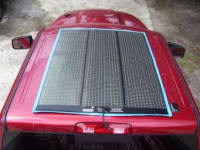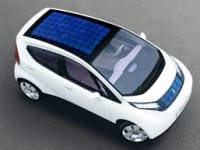AIM: SAVE FUEL ENERGY (DIESEL,PETROL,CNG).
SURVEY: It has been observed that if on a hot day you drive along and perhaps note that the fuel consumption on your on board computer shows 34 mpg and you turn on the AC and it immediately drops to 28 mpg it would be easy to assume that you were losing 6 mpg for the AC. Usually, a car consume 15% of the total fuel to run AC in a car. For example, if a car gives a mileage of 30 km/litre with AC switched off, then it will give a mileage of 25.5 km/litre with A/C switched ON.
RESOURCE USED: thin solar cell film and a photovoltaic battery.
DESCRIPTION: As we know that every car faces sun rays for at least 5 hours/day and most of the parts of a car body are in direct contact with sun rays. if we placed a thin-film of solar cells on the car roof top and on the bonnet of car, we can accumulate enough amount of energy to run our A/C. When the sun rays fall on a car's body, solar cell film converts the heat energy of the sun into electrical energy through a path of circuit and stored in a photovoltaic battery, and this battery is used run AC when needed.
A thin-film solar cell (TFSC), also called a thin-film photovoltaic cell (TFPV), is a solar cell that is made by depositing one or more thin layers (thin film) of photovoltaic material on a substrate. Thin-film technologies reduce the amount of material required in creating the active material of solar cell. Most thin film solar cells are sandwiched between two panes of glass to make a module. The performance and potential of thin-film materials are high, reaching cell efficiency of 12–20%; prototype module efficiency of 7–13%; and production modules in the range of 9%.Photovoltaics is the field of technology and research related to the practical application of photovoltaic cells in producing electricity from light, though it is often used specifically to refer to the generation of electricity from sunlight. Cells can be described as photovoltaic even when the light source is not necessarily sunlight (lamplight, artificial light, etc.). In such cases the cell is sometimes used as a photodetector (for example infrared detectors), detecting light or other electromagnetic radiation near the visible range, or measuring light intensity.
WORKING of solar cell: Solar (or photovoltaic) cells convert the sun’s energy into electricity which used to run A/C. A solar cell (also called a photovoltaic cell) is an electrical device that converts the energy of light directly into electricity by the photovoltaic effect. It is a form of photoelectric cell (in that its electrical characteristics—e.g. current, voltage, or resistance—vary when light is incident upon it) which, when exposed to light, can generate and support an electric current without being attached to any external voltage source, but do require an external load for power consumption.
CONCLUSION: By doing so,we can enhance our car efficiency upto 4.5 km/litre or 11 rupees/litre (approximate data).
Voting
-
ABOUT THE ENTRANT
- Name:Pallav Shrivastava
- Type of entry:individual
- Patent status:none








